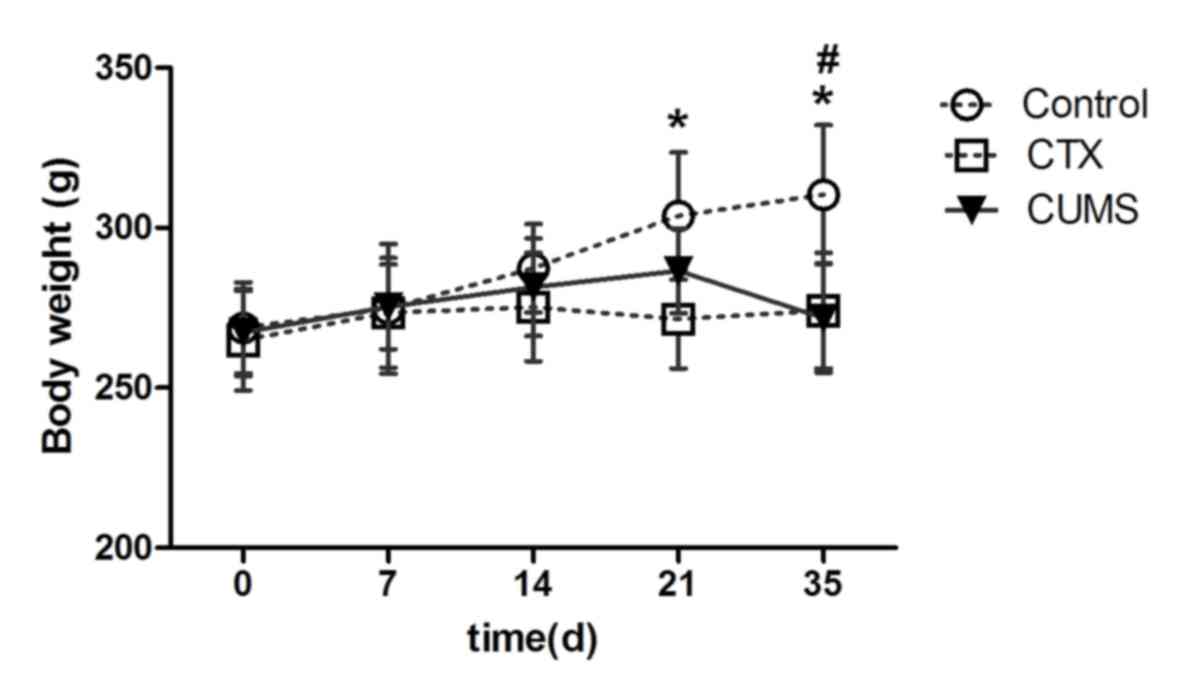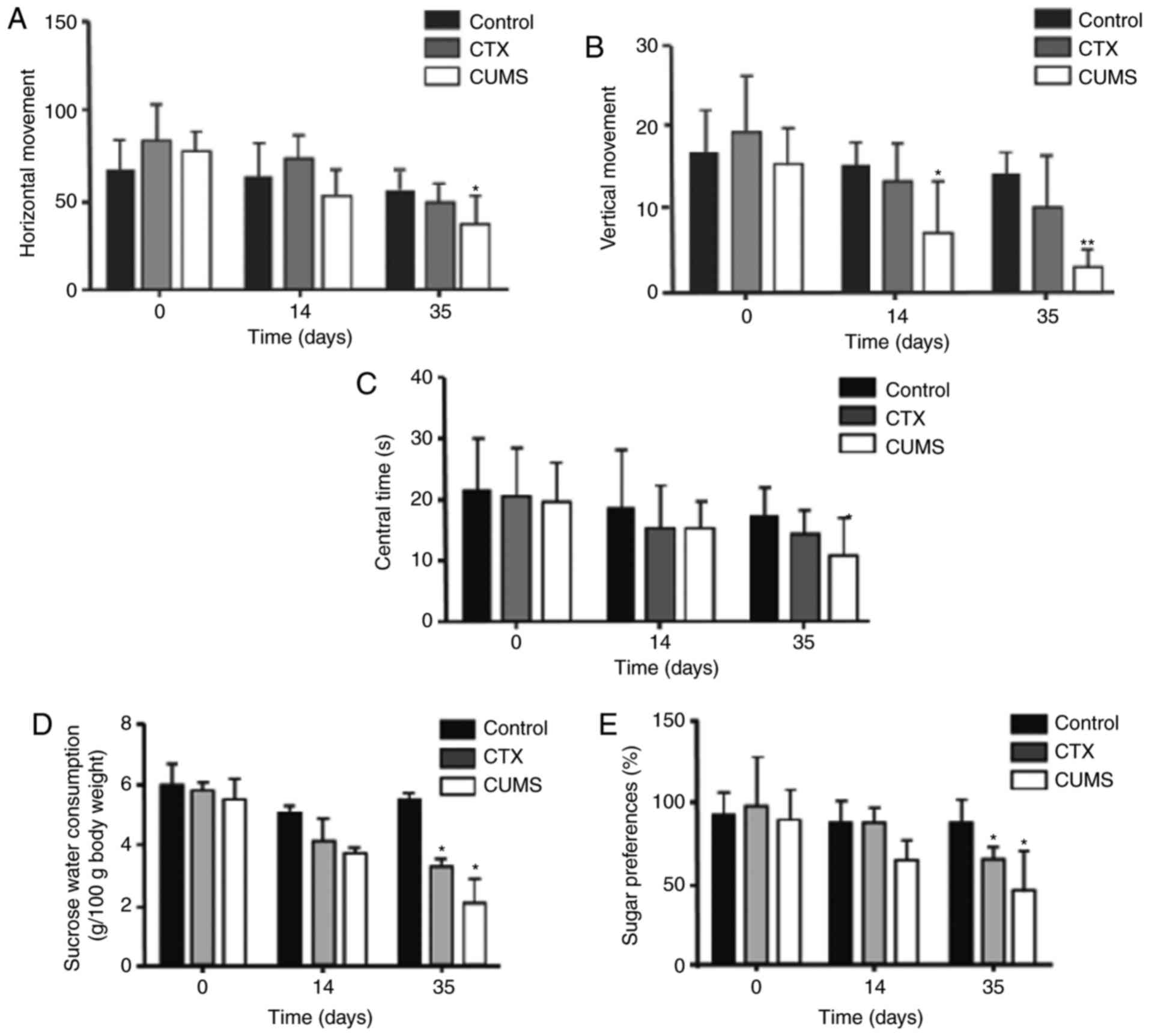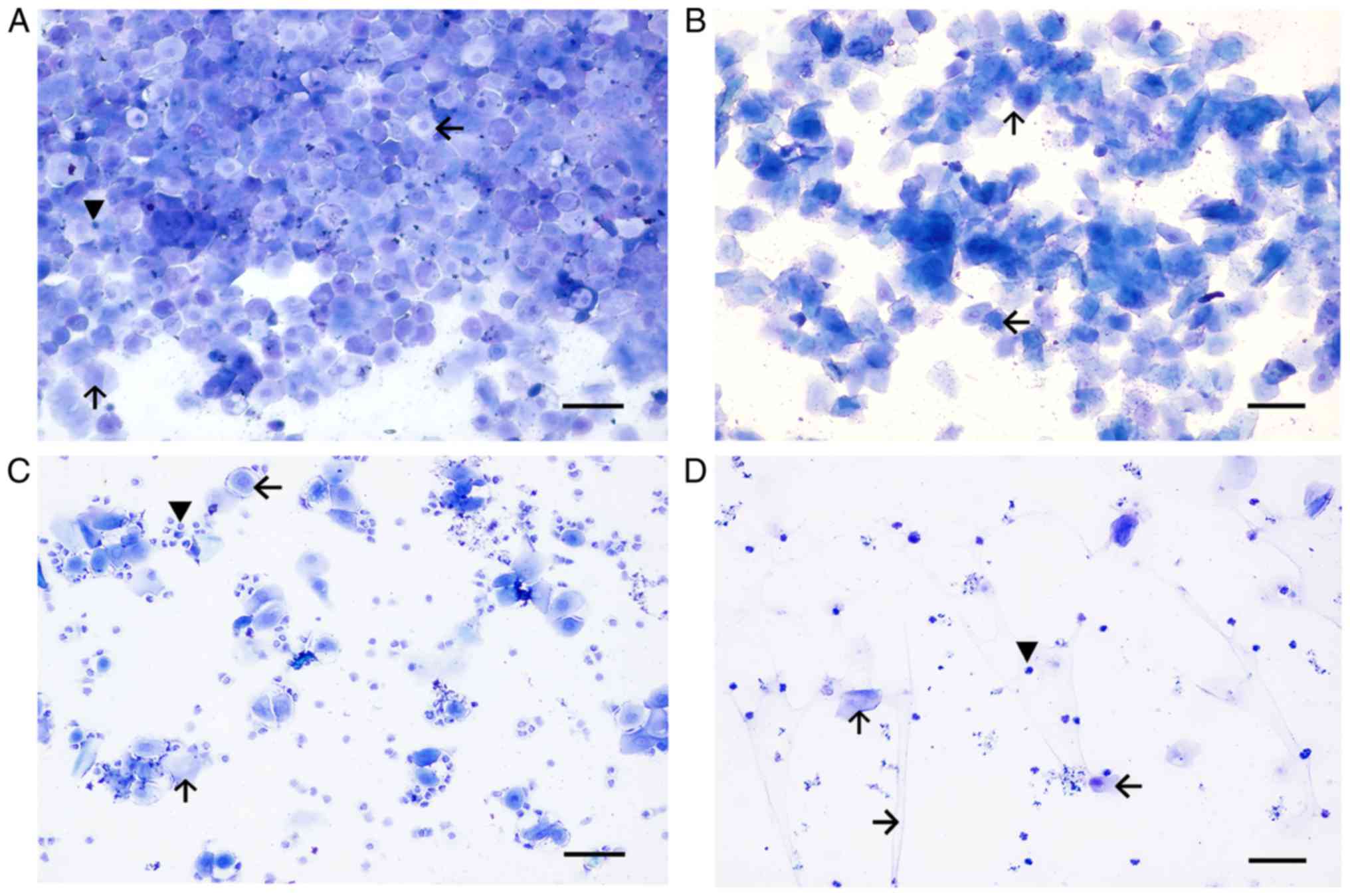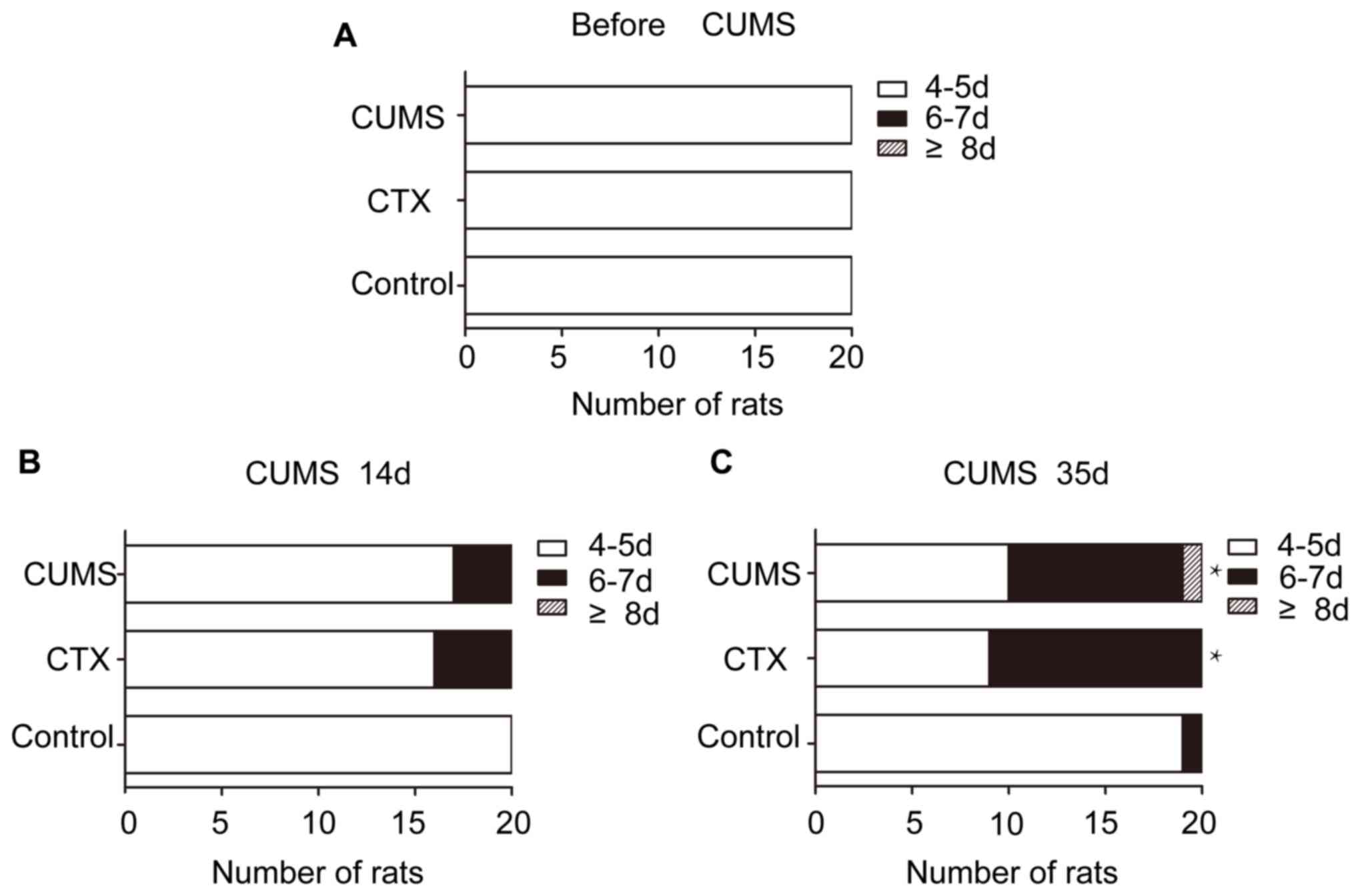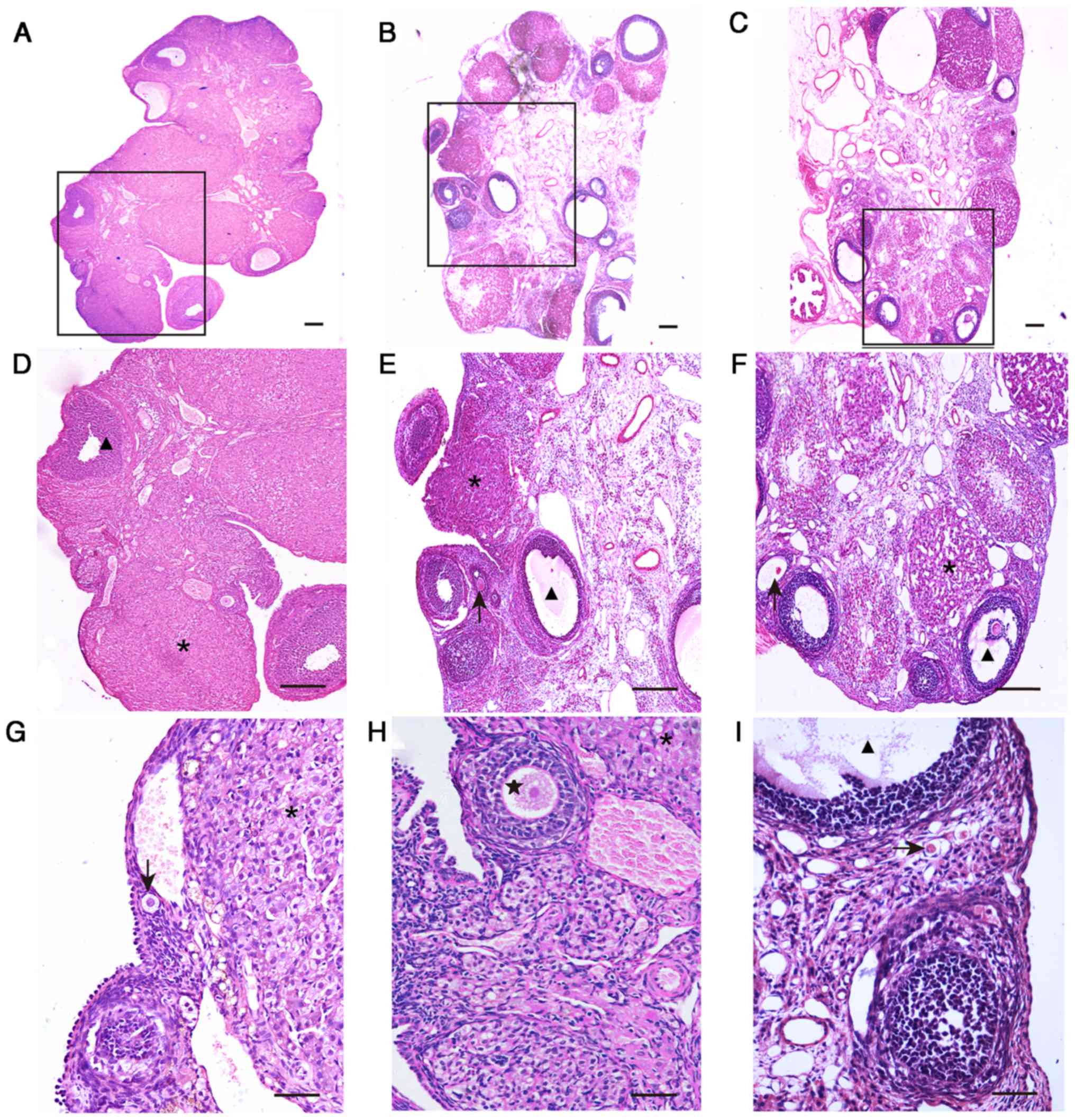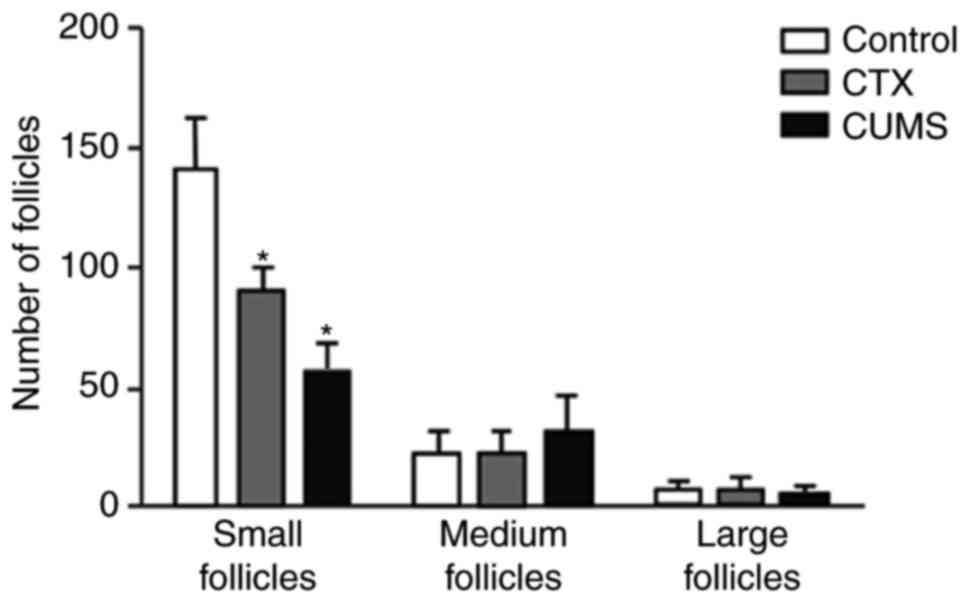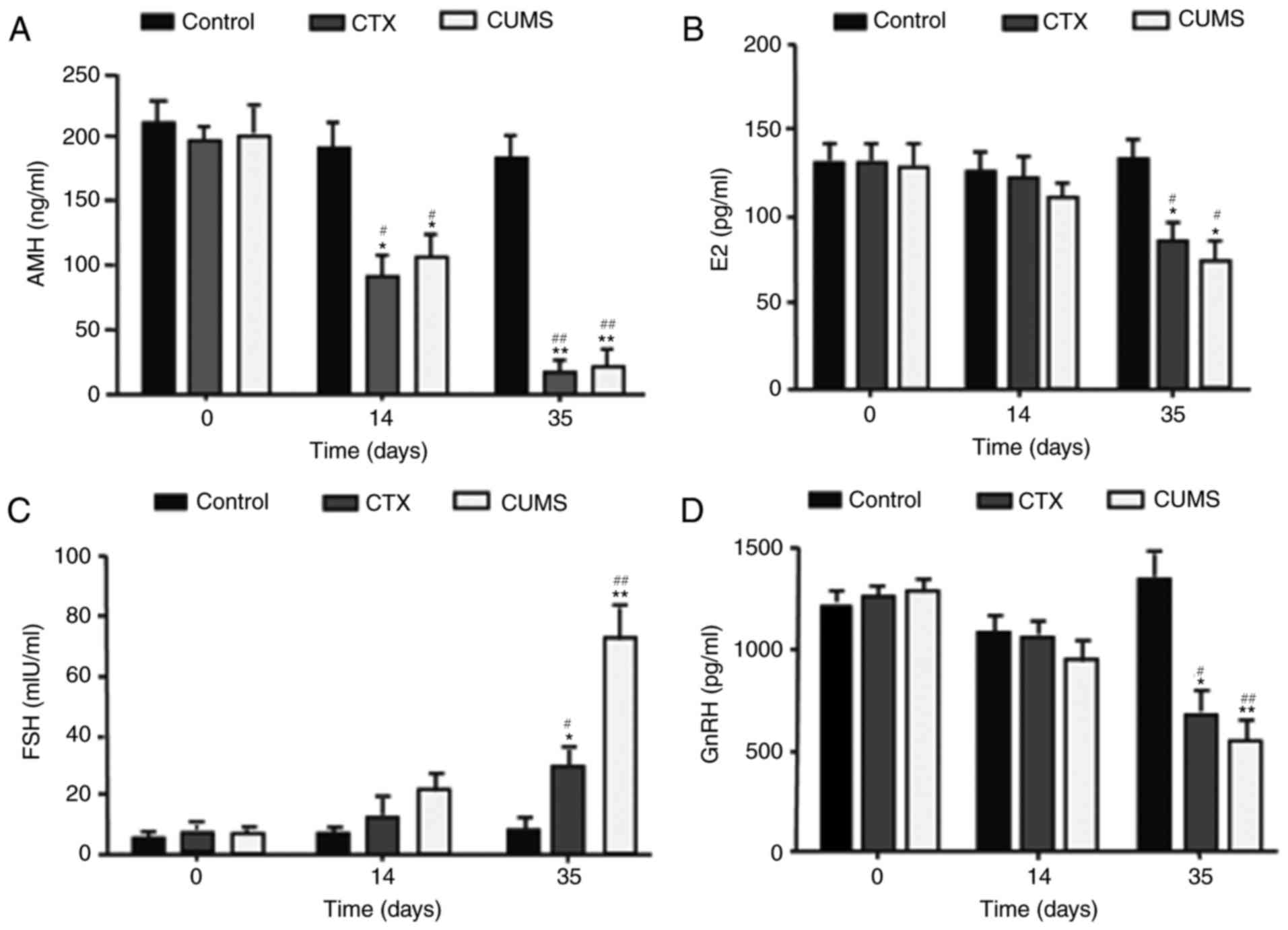Effects of chronic unpredictable mild stress on ovarian reserve in female rats: Feasibility analysis of a rat model of premature ovarian failure
- Authors:
- Published online on: May 8, 2018 https://doi.org/10.3892/mmr.2018.8989
- Pages: 532-540
Abstract
Introduction
Premature ovarian failure (POF) can result from various factors, including iatrogenic chemotherapy and radiotherapy, autoimmune diseases, genetic defects and idiopathy (1). POF may lead to premature failure of ovarian function, which is primarily characterized by menopausal symptoms, including low estrogen levels and high gonadotropin levels. POF causes infertility and may also lead to a series of nervous system, cardiovascular and metabolic diseases, including Alzheimer's disease, hypercholesterolemia and early-onset osteoporosis, due to hormone deficiencies (2) that may severely affect women's health. However, the pathogenesis of POF remains unclear.
Studies have reported that the occurrence of POF is closely associated with depression, anxiety and other negative emotions (3,4). Approximately 43% of patients with POF in the USA report a history of depression, of whom 26% have experienced depression (4) 5 years prior to POF diagnosis. This clinical evidence demonstrates that chronic psychological stress, including anxiety and depression, may damage female ovarian function leading to disorders of female reproductive endocrine function. Barra et al (5) demonstrated that chronic cold stress may cause ovarian dysfunction or POF in female adult rats. This phenomenon is characterized by a prolonged sexual cycle or a lack of physiological regulation, and decreased secretion of estradiol and progesterone. Chronic cold stress may cause ovarian dysfunction in female adult rats in addition to reducing the number of primordial, primary and secondary follicles in the ovary, decreasing the expression of follicle-stimulating hormone (FSH) receptor, and delaying sexual development in young rats (6). The above evidence suggests that chronic stress may be a crucial factor in the pathogenesis of POF.
Since the etiology of POF is diverse and complex, the pathogenesis of this disease remains unclear. To explore the mechanisms as to how POF may be caused by different disorders, animal models are essential. At present, two animal models of POF are available including, the chemotherapy (7) and 4-vinylcyclohexene diepoxide (8) models. However, a POF model induced by chronic stress has not been developed so far.
Chronic unpredictable mild stress (CUMS) is a widely used method for establishing models of depression, as proposed by Willner et al (9) in 1987, and includes a variety of chronic mild stresses: Wet bedding, behavior restriction, fasting, water deprivation, forced swimming, ice water, noise, hanging upside down day and night, and tail and foot shock. Compared with single factor model, the multifactor complex chronic stress model exhibits the characteristics of variability and an unpredictable stress source, which may induce a psychological stress response. However, whether the CUMS model may be used to assess POF remains unknown. In the present study, adult female rats were treated with the CUMS method to analyze the effects of chronic psychological stress on ovarian reserve, in order to demonstrate the feasibility of establishing a POF model via the CUMS method. This approach may provide a suitable animal model for further assessment of the pathogenesis of chronic stress-induced POF.
Materials and methods
Animals
A total of 60 specific pathogen-free healthy female nulligravid Sprague-Dawley rats, (12 weeks old; 238±26 g), were provided by the Zhejiang Provincial Animal Experimental Center [animal certificate no. SXXK (Zhejiang) 2014-0001]. The housing conditions were as follows: Room temperature 20–25°C, relative humidity 45–60%, 12 h light-dark cycle, drinking distilled water ad libitum throughout the experiment. The present study was approved by the Medical Ethics Committee of Jinhua Polytechnic (Jinhua, China).
Experimental grouping and POF model establishment
After 7 days of adaptation to the above conditions, the rats were randomly divided into three groups (n=20), including the control, cyclophosphamide (CTX) and CUMS groups. The control rats were grabbed once daily by gently catching the tail and skin of the back, and fixed for 5 sec, without any specific treatment. The CTX group received an intraperitoneal injection of CTX (Baxter Oncology GmbH, Halle, Germany) at a dose of 50 mg/kg on the first experimental day, followed by 8 mg/kg/day for 14 days and were fed normally for 2 months (10). Rats of the CUMS group were housed individually and exposed to a set of CUMS procedures repeatedly as follows (9): Wet pad for 24h, behavioral restriction for 2 h, fasting for 24 h, water deprivation for 24 h, forced ice water swimming at 4°C for 5 min, reversal of day and night for 24 h, noise interference for 12 h, tail suspension for 30 min, and plantar electric shock (30 V) for 5 sec. A stimulus was randomly administered daily for ≤35 days.
Rat estrous cycle assessment. Following adaptive feeding for approximately 7 days, the estrous cycles of the rats were monitored continuously by vaginal smear for 10 days. Vaginal cytology was performed at 8:30 a.m. First, the rats were held, and cotton swabs were moistened with saline and inserted into the vagina, gently rotating twice against the vaginal wall. The swab was removed and rolled on the slide. The obtained smears were air-dried and stained for 3–5 min with alkaline methylene blue (pH 8.4) at room temperature. Following washing, the smears were air-dried and observed by optical microscopy (magnification, ×100), to determine the estrous cycle stages, including the proestrus, estrus, metestrus and diestrus. The criteria have been described elsewhere (Table I) (11).
Table I.Basic classification of estrous cycle stages based on cell types and their relative numbers in vaginal smears. |
Open field test
Animal activity was observed prior to and following modeling on days 7, 14, 21 and 28, respectively. The box used for the open field test was 100×100×50 cm. The bottom of the box was divided into 25 squares (20×20 cm each). Each rat was placed in the central square for an individual test. Then the subsequent spontaneous activity of each individual rat was recorded for 3 min under dark and quiet conditions. The total distance traveled was considered a measure of motor ability based on the frequency of the rat crossing any of the 25 squares. The total duration of stay in the central area was calculated and defined as a measure of anxiety. The vertical frequency was used to assess the exploratory ability of the rats based on the frequency of rearing (raising both forelimbs >1 cm from the ground or clinging to the walls). Prior to each test, the box was completely cleaned. The behavioral assessment was conducted in a quiet room by two observers between 8:00 a.m. and 12:00 p.m. at 25°C under (10±1) kPa. The data from the two observers were averaged as the final analysis (12).
Sucrose consumption test
The animals were trained to adapt to sugary drinking prior to the experiment in a quiet room at 25°C under (10±1) kPa in single cages (54.5×39.5×20 cm). Each cage had two bottles of 1% sucrose water placed simultaneously during the first 24 h, followed by one bottle each of 1% sucrose water and pure water in the subsequent 24 h. After 23 h of fasting, the animals underwent the sucrose consumption test. Each rat was given two bottles of water randomly placed at the same time: one contained 1% sucrose water and the other having pure water. The two bottles were removed and weighed after 1 h. Finally, sugar consumption was measured, as well as sucrose preference (sucrose preference=sugar consumption/total liquid consumption ×100) was calculated (12).
Ovarian morphology
Bilateral ovaries of the rats were removed and fixed with 10% formaldehyde at 4°C for 24 h, dehydrated by an ethanol gradient (70% for 8 h, 80% for 2 h, 90% for 1 h, 95% for 30 min and twice with 100% for 15 min) at room temperature, paraffin embedded, and sectioned in ~6 µm slices. The ovarian tissue sections were stained with hematoxylin-eosin (hematoxylin for 5 min and eosin for 2 min) at room temperature. The stained ovarian tissue specimens were observed by light microscopy (magnification, ×100) to assess the structural alterations and enumerate follicles in all groups. The follicular grading criteria by Yoshida et al (13) are described as follows: Small follicles, including primordial and primary follicles, are those with oocyte diameter <20 µm and <20 follicle cells; medium follicles oocyte diameter in the range of 20–70 µm and a follicle cell number of 21–200; large follicles, oocyte diameter >70 µm and >201 follicle cells.
Serum levels of gonadotropin releasing hormone (GnRH), FSH, estradiol (E2), and anti-Mullerian hormone (AMH)
Blood samples (2–3 ml) were drawn from the posterior venous plexus of rats, and placed at room temperature. Following blood coagulation, serum was obtained by centrifugation (600 × g at room temperature for 10 min). The levels of GnRH, FSH, E2 and AMH in serum were detected using ELISA kits (CusaBio Biotech Co., Ltd., Wuhan, China; E2, cat. no. CSB-E05110r; AMH, cat. no. CSB-E11162r; FSH, cat. no. CSB-E06869r; GnRH, cat. no. CSB-E08037r), according to the manufacturer's instructions. Standard curves were plotted using the Curve Expert 1.3 software (Hyams Development, Huntsville, Alabama). The regression equation was fitted by the concentration values of standard substance and its corresponding optical density values (OD value). The OD value of each well was sequentially measured with a microplate reader BIO-RAD Model 680, Bio-Rad Laboratories Inc, Hercules, CA, USA) at a wavelength of 450 nm. Analysis was performed within 10 min following termination of the reaction. Then the optical density values of the detected sample were substituted into the equation, then the sample concentration was calculated.
Statistical methods
The data were assessed using SPSS 20.0 statistical software (IMB Corp., Armonk, NY, USA). Measurement data are expressed as the mean ± standard deviation. Single factor analysis of variance was applied for multi-group comparisons, with post hoc tests (Dunnett's tests) used to compare group pairs. Enumeration data were analyzed by the nonparametric Kruskal-Wallis test, using a nonparametric post hoc test (LSD test). P<0.05 was considered statistically significant.
Results
Treatment with CUMS reduces the body weight of rats
Body weights were recorded to assess the effects of CUMS on rats. From day 21, the weight of rats of the control group were significantly higher than those of the CTX group (P<0.05). At day 35, the weight of the rats in the CUMS and CTX groups were significantly reduced compared with in the control group (P<0.05). However, at other time points, the CUMS group showed no statistically significant difference (Fig. 1). This finding suggested that similar to CTX, treatment with CUMS resulted in significant reductions in body weight of rats at day 35.
Treatment with CUMS induces chronic psychological stress in rats
In the present study, two behavioral evaluation assays were used, including the open field test and sugar syrup preference tests, to assess whether treatment with CUMS induces chronic psychological stress in rats (Fig. 2). On day 14 (Fig. 2B) following model establishment, vertical movement was significantly decreased in the CUMS group compared with the control group (P<0.05). On day 35 after following model establishment, vertical movement was significantly decreased in the CUMS group compared with in the control group (P<0.01). Horizontal movement (Fig. 2A) and central time (Fig. 2C) in the CUMS group were significantly decreased compared with the control (P<0.05) on day 35. Consistently, sugar consumption (Fig. 2D) and sugar preference (Fig. 2E) were significantly decreased in the CUMS and CTX groups compared with control rats (P<0.05), again only on day 35. In addition, the CTX and CUMS groups did not exhibit statistically significant differences at any time point (P>0.05) for all factors (Fig. 2). The open field and sucrose preference tests demonstrated that the CUMS group exhibited depressive-like behaviors at 35 days post-treatment with CUMS.
Treatment with CUMS prolongs the estrous cycle in rats
Prior to establishment, all three groups presented a regular estrous cycle (Fig. 3). The duration of the normal estrous cycle was 4–5 days, constituting the proestrus (Fig. 3A), estrus (Fig. 3B), metestrus (Fig. 3C) and diestrus (Fig. 3D) of 1, 0.5, 1, 1.5–2 days, respectively. At the end of modeling, 12 rats in the CTX group and 9 rat in the CUMS group exhibited an estrous cycle of 6–7 days. Abnormal estrous cycles in the CTX (P<0.05) and CUMS groups (P<0.05) were significantly different compared with control after 35 days of treatment with CUMS (Fig. 4). The estrous cycle was primarily manifested as continuous diestrus. The CTX and CUMS groups appeared to show estrous cycle extension; however, no rat exhibited disappearance of the estrous cycle.
Treatment with CUMS results in morphological alterations and decreased follicular counts in the ovaries of rats
On day 35 following model establishment, ovaries of the CTX and CUMS group rats exhibited notable atrophy compared with the control group. The primary histological alterations were as follows. First, analysis of the ovarian stroma revealed severe fibrosis, cortical thickening and a disorganized structure. Secondly, the number of follicles at each stage of ovarian development were reduced, while atretic follicles were markedly increased. In addition, the corpus luteum exhibited fibrosis and increased in number (Fig. 5). The number of small follicles were obtained in serial sections, and was observed to be 85.50±37.57 and 58.90±26.25 in the CTX and CUMS groups, respectively. These values were significantly decreased compared with the control amounts of 137.13±48.55 (P<0.05). However, no significant differences were observed in the amounts medium and large follicles in the CTX and CUMS groups compared with their respective control groups (Fig. 6). Morphological assessment of ovaries in the CTX and CUMS groups demonstrated abnormal alterations, with the number of small follicles decreasing significantly.
Treatment with CUMS reduces the levels of serum E2, AMH and GnRH, and elevates FSH levels in rats
Prior to modeling, no significant differences were observed in E2, AMH, GnRH, and FSH levels among the three groups. On day 14, serum E2, AMH, and GnRH levels in the CTX and CUMS groups were decreased compared with control values; with the difference of AMH being statistically significant (P<0.05). However, FSH levels were higher in the CTX and CUMS groups compared with control group, without significant differences. In addition, serum E2, AMH, and in the GnRH levels were significantly decreased on day 35 in the CTX and CUMS groups compared with in the control group (P<0.05), while FSH levels in the CTX (P<0.05) and CUMS (P<0.01) groups were significantly higher than the control group. Furthermore, E2, AMH, and GnRH levels on day 35 in the CTX and CUMS groups were lower than those obtained before modeling (P<0.05), while FSH levels were significantly higher compared with in the respective control groups (CTX, P<0.05; CUMS, P<0.01) (Fig. 7). These findings indicated that the serum levels of the serum hormones E2, AMH, GnRH and FSH were altered in the CTX and CUMS groups.
Discussion
Establishing an animal model is essential for assessing the association of chronic stress with POF. The present study examined the feasibility of the CUMS method in developing a rat model of POF. CUMS has been used to establish a model of depression, and may cause chronic psychological stress in rats, therefore, it was used in the present study (9). CUMS may cause behavioral effects, including anxiety and depression-like behaviors in rats. In addition, chronic psychological stress may alter reproductive endocrine function in rats (5,6), which ultimately leads to ovarian dysfunction and premature ovarian failure (14). The present study performed open field and sugar consumption tests to evaluate anxiety and depression-like behaviors in rats, in order to determine whether the animals have developed psychological stress. As aforementioned, body weight, time spent in the center, horizontal movement and vertical frequency were all significantly decreased. In addition, sucrose consumption and preference were significantly reduced. In addition, the estrous cycle was prolonged significantly. Furthermore, serum E2, AMH and GnRH levels decreased significantly, while FSH levels were significantly increased. Furthermore, significantly fewer small follicles were detected in the CUMS group compared with the control following model establishment.
In the open field test, horizontal movement, vertical movement and central residence time were significantly decreased in CUMS-treated rats compared with the control group, supporting the findings of Strekalova et al (15), which demonstrated that chronic stress may cause horizontal movement in model animals. The rats that experienced chronic stress were predisposed to avoid the central grid. Reduction in central residence in the open box was a manifestation of fear of danger, attributed to autonomic nervous system dysfunction, or may reflect a lack of curiosity about the environment (16). Vertical movement reflects the inquiring behavior of rats and confidence in an unfamiliar environment (17). The aforementioned results revealed a decreased interest in the unfamiliar environment in rats under chronic stress. The sugar preference test may be a crucial method for the detection of anhedonia (18,19), which is a core symptom of clinical depression. The sugar preference test revealed that sugary water consumption and sucrose preference were decreased significantly in the CUMS group compared with the control group, indicating anhedonia in these animals. Behavioral evidence uncovered by tests conducted in the present study demonstrated that the rats demonstrated a degree of depressive symptoms following modeling. These findings suggested that the CUMS program may induce chronic psychological stress in rats.
The animals experiencing chronic stress exhibit ovarian dysfunction in addition to behavioral alterations. Vaginal cytology is an essentially noninvasive procedure for evaluating the estrous cycle in laboratory rodents and may serve as a useful measure of the integrity of the hypothalamic-pituitary-ovarian reproductive axis (20). The aforementioned experimental results revealed that the estrous cycle of rats of the CTX and CUMS groups was prolonged significantly, particularly due to prolonged diestrus. This finding suggested that treatment with CUMS, similar to CTX, may cause dysfunction of the hypothalamic-pituitary-ovarian axis in rats. In addition to the estrous cycle, serum hormones, including E2 and FSH, are essential for the evaluation of POF models. POF is biochemically characterized by low levels of gonadal hormones (estrogens) and high levels of gonadotropins (FSH) (21). AMH is a crucial index in evaluating the ovarian reserve (22). The present study revealed that the serum levels of E2 and AMH were decreased significantly, while FSH amounts were significantly increased in CUMS-treated rats, similar to those of the CTX group. These findings were in accordance with those of Lu et al (23), who reported E2 and AMH levels in CUMS rats with stress resulted in disordered estrous cycles. Thus, these characteristics were consistent with those reported in POF models induced by chemotherapeutics (24,25). A marked decrease in AMH hormone suggested a declined ovarian reserve. Taken together, the alterations in hormonal levels and prolonged estrous cycles demonstrated that CUMS-treated rats exhibited ovarian dysfunction similar to CTX-treated rats. Thus, treatment with CUMS may affect the hypothalamus-pituitary-gonadal axis, resulting in ovary dysfunction.
Morphological assessment demonstrated that, compared with control rats, ovarian tissues of the CTX and CUMS groups exhibited interstitial fibrosis, cortex thickening and disorganized tissue structure; alterations in the CTX group were more pronounced compared with those of the CUMS group. These fibrotic alterations were consistent with previous findings evaluating ovarian tissues in patients with POF (26). Additionally, significantly fewer follicles, particularly primitive follicles, were observed following model establishment. The aforementioned morphological alterations were consistent with those of ovarian tissue samples in the chemotherapeutic CTX model (27). Furthermore, the morphological evidence suggested that chronic stress may modify ovarian structure, similar to treatment with CTX.
An ideal animal model should have the following characteristics: First, pathogenic pathways and processes similar to those observed in humans; secondly, pathological alterations in the model may be reversed by drugs; and thirdly, reproducibility of results. The present model has the following advantages, according to the aforementioned criteria. The modeling method is consistent with known primary pathogenic factors of human POF, with the pathogenic pathway and pathological alterations being similar to clinical observations. In addition, the modeling method of CUMS is simple and feasible; it may induce chronic psychological stress and cause depression or anxiety in rats. Finally, it may induce a number of POF features in experimental animals, including alterations in serum hormone levels and ovarian morphology, and prolongation estrous cycle. However, the model has a limitation in that the estrous cycle the experimental animals did not disappear.
Due to different animal strain, various modeling methods and evaluation indexes have been adopted by researchers; thus, a POF animal model has not been established as a unified evaluation standard. The majority of these models have been tested for serological hormones, particularly E2 and FSH. However, these hormones do not constitute a precise standard for assessment, unlike the diagnostic criteria for human POF. A simple and efficient estrous cycle, as an evaluation index of the rodent reproductive function, may be combined with serum E2, FSH and AMH levels to construct an ideal and accurate evaluation system for the POF animal model. The estrous cycle of most experimental animals did not disappear in the present study. The CUMS model was able to cause psychological stress and induce ovarian dysfunction in rats. However, whether the CUMS model induces POF efficiently in experimental animals requires further investigation.
The aforementioned CUMS POF animal model revealed that CUMS may lead to ovarian dysfunction. The results of the present study suggested that the CUMS model may provide possible directions and research approaches for ovarian dysfunction and POF, caused by psychological stress. Further studies are required to evaluate the interaction between psychological stress and ovarian function in order to define the pathogenesis of psychological stress-associated human ovarian dysfunction and POF.
Acknowledgements
Not applicable.
Funding
The present study was supported by a grant from the Experimental Animal Science and Technology Project of Zhejiang Province, China (grant no. 2015C37104).
Availability of data and materials
Not applicable.
Authors' contributions
XYF and HHC made substantial contributions to the concept and design of the present study. YEQ, YSF conducted animal feeding and model establishment. XYF, HHC, NZ conducted open field test, sucrose consumption test and ELISA. XMP conducted morphological evaluation of ovarian tissue samples. YPL and QZ conducted ELISA. WQW and MXD performed statistical analysis; XYF drafted the manuscript. XYF, HHC and MXD critically revised the manuscript for important intellectual content. All authors gave final approval, and agreed to be accountable for all aspects of work in ensuring that questions regarding the accuracy or integrity of any part of the work are appropriately investigated and resolved.
Ethics approval and consent to participate
The present study was approved by the Medical Ethics Committee of Jinhua Polytechnic (Jinhua, China).
Consent for publication
Not applicable.
Competing interests
The authors declare that they have no competing interests.
Glossary
Abbreviations
Abbreviations:
|
AMH |
anti-Mullerian hormone |
|
CTX |
cyclophosphamide |
|
CUMS |
chronic unpredictable mild stress |
|
E2 |
estradiol |
|
FSH |
follicle-stimulating hormone |
|
GnRH |
gonadotropin releasing hormone |
|
POF |
premature ovarian failure |
References
|
Shelling AN: Premature ovarian failure. Reproduction. 140:633–641. 2010. View Article : Google Scholar : PubMed/NCBI | |
|
Shuster LT, Rhodes DJ, Gostout BS, Grossardt BR and Rocca WA: Premature menopause or early menopause: long-term health consequences. Maturitas. 65:161–166. 2010. View Article : Google Scholar : PubMed/NCBI | |
|
Tseng LA, El Khoudary SR, Young EA, Farhat GN, Sowers M, Sutton-Tyrrell K and Newman AB: The association of menopause status with physical function: The Study of Women's Health Across the Nation. Menopause. 19:1186–1192. 2012. View Article : Google Scholar : PubMed/NCBI | |
|
Allshouse AA, Semple AL and Santoro NF: Evidence for prolonged and unique amenorrhea-related symptoms in women with premature ovarian failure/primary ovarian insufficiency. Menopause. 22:166–174. 2015. View Article : Google Scholar : PubMed/NCBI | |
|
Barra R, Cruz G, Mayerhofer A, Paredes A and Lara HE: Maternal sympathetic stress impairs follicular development and puberty of the offspring. Reproduction. 148:137–145. 2014. View Article : Google Scholar : PubMed/NCBI | |
|
Dorfman M, Arancibia S, Fiedler JL and Lara HE: Chronic intermittent cold stress activates ovarian sympathetic nerves and modifies ovarian follicular development in the rat. Biol Reprod. 68:2038–2043. 2003. View Article : Google Scholar : PubMed/NCBI | |
|
Liu TE, Wang S, Zhang L, Guo L, Yu Z, Chen C and Zheng J: Growth hormone treatment of premature ovarian failure in a mouse model via stimulation of the Notch-1 signaling pathway. Exp Ther Med. 12:215–221. 2016. View Article : Google Scholar : PubMed/NCBI | |
|
Li J, Fan S, Han D, Xie J, Kuang H and Ge P: Microarray gene expression profiling and bioinformatics analysis of premature ovarian failure in a rat model. Exp Mol Pathol. 97:535–541. 2014. View Article : Google Scholar : PubMed/NCBI | |
|
Willner P, Towell A, Sampson D, Sophokleous S and Muscat R: Reduction of sucrose preference by chronic unpredictable mild stress, and its restoration by a tricyclic antidepressant. Psychopharmacology (Berl). 93:358–364. 1987. View Article : Google Scholar : PubMed/NCBI | |
|
Sun M, Wang S, Li Y, Yu L, Gu F, Wang C and Yao Y: Adipose-derived stem cells improved mouse ovary function after chemotherapy-induced ovary failure. Stem Cell Res Ther. 4:802013. View Article : Google Scholar : PubMed/NCBI | |
|
Cora MC, Kooistra L and Travlos G: Vaginal cytology of the laboratory rat and mouse: Review and criteria for the staging of the estrous cycle using stained vaginal smears. Toxicol Pathol. 43:776–793. 2015. View Article : Google Scholar : PubMed/NCBI | |
|
Chen HH, Zhang N, Li WY, Fang MR, Zhang H, Fang YS, Ding MX and Fu XY: Overexpression of brain-derived neurotrophic factor in the hippocampus protects against post-stroke depression. Neural Regen Res. 10:1427–1432. 2015. View Article : Google Scholar : PubMed/NCBI | |
|
Yoshida M, Sanbuissyo A, Hisada S, Takahashi M, Ohno Y and Nishikawa A: Morphological characterization of the ovary under normal cycling in rats and its viewpoints of ovarian toxicity detection. J Toxicol Sci. 34 Suppl 1:SP189–SP197. 2009. View Article : Google Scholar : PubMed/NCBI | |
|
Omu FE, Biaa AAME, Ghafour AA, Gadalla IT and Omu AE: Emotional impacts of premature ovarian failure in Kuwait. Health. 8:262–278. 2016. View Article : Google Scholar | |
|
Strekalova T, Evans M, Chernopiatko A, Couch Y, Costa-Nunes J, Cespuglio R, Chesson L, Vignisse J, Steinbusch HW, Anthony DC, et al: Deuterium content of water increases depression susceptibility: the potential role of a serotonin-related mechanism. Behav Brain Res. 277:237–244. 2015. View Article : Google Scholar : PubMed/NCBI | |
|
Prut L and Belzung C: The open field as a paradigm to measure the effects of drugs on anxiety-like behaviors: A review. Eur J Pharmacol. 463:3–33. 2003. View Article : Google Scholar : PubMed/NCBI | |
|
Haloui M, Tahraoui A, Bououza F, Bairi A, Boukhris N, Boulaakoud M and Ouakid M: Effects of chronic restraint stress on energetic metabolism and the evolution of depression, evaluated in the Open Field test in female wistar rat. Ann BiolRes. 5:1–7. 2014. | |
|
Baker SL, Kentner AC, Konkle AT, Barbagallo Santa-Maria L and Bielajew C: Behavioral and physiological effects of chronic mild stress in female rats. Physiol Behav. 87:314–322. 2006. View Article : Google Scholar : PubMed/NCBI | |
|
Schweizer MC, Henniger MS and Sillaber I: Chronic mild stress (CMS) in mice: of anhedonia, ‘anomalous anxiolysis’ and activity. PLoS One. 4:e43262009. View Article : Google Scholar : PubMed/NCBI | |
|
Goldman JM, Murr AS and Cooper RL: The rodent estrous cycle: characterization of vaginal cytology and its utility in toxicological studies. Birth Defects Res B Dev Reprod Toxicol. 80:84–97. 2007. View Article : Google Scholar : PubMed/NCBI | |
|
Beck-Peccoz P and Persani L: Premature ovarian failure. Orphanet J Rare Dis. 1:92006. View Article : Google Scholar : PubMed/NCBI | |
|
Helden JV and Weiskirchen R: Age-independent anti-Mullerian hormone (AMH) standard deviation scores to estimate ovarian function. Eur J Obstet Gynecol Reprod Biol. 213:64–70. 2017. View Article : Google Scholar : PubMed/NCBI | |
|
Lu J, Wu XY, Zhu QB, Li J, Shi LG, Wu JL, Zhang QJ, Huang ML and Bao AM: Sex differences in the stress response in SD rats. Behav Brain Res. 284:231–237. 2015. View Article : Google Scholar : PubMed/NCBI | |
|
Elfayomy AK, Almasry SM, El-Tarhouny SA and Eldomiaty MA: Human umbilical cord blood-mesenchymal stem cells transplantation renovates the ovarian surface epithelium in a rat model of premature ovarian failure: Possible direct and indirect effects. Tissue Cell. 48:370–382. 2016. View Article : Google Scholar : PubMed/NCBI | |
|
Song D, Zhong Y, Qian C, Zou Q, Ou J, Shi Y, Gao L, Wang G, Liu Z, Li H, et al: Human umbilical cord mesenchymal stem cells therapy in cyclophosphamide-induced premature ovarian failure rat model. Biomed Res Int. 2016:25175142016. View Article : Google Scholar : PubMed/NCBI | |
|
Haidar MA, Baracat EC, Simoes MJ, Focchi GR, Neto Evencio J and de Lima GR: Premature ovarian failure: Morphological and ultrastructural aspects. Sao Paulo Med J. 112:534–538. 1994. View Article : Google Scholar : PubMed/NCBI | |
|
Liu T, Wang S, Li Q, Huang Y, Chen C and Zheng J: Telocytes as potential targets in a cyclophosphamide-induced animal model of premature ovarian failure. Mol Med Rep. 14:2415–2422. 2016. View Article : Google Scholar : PubMed/NCBI |



